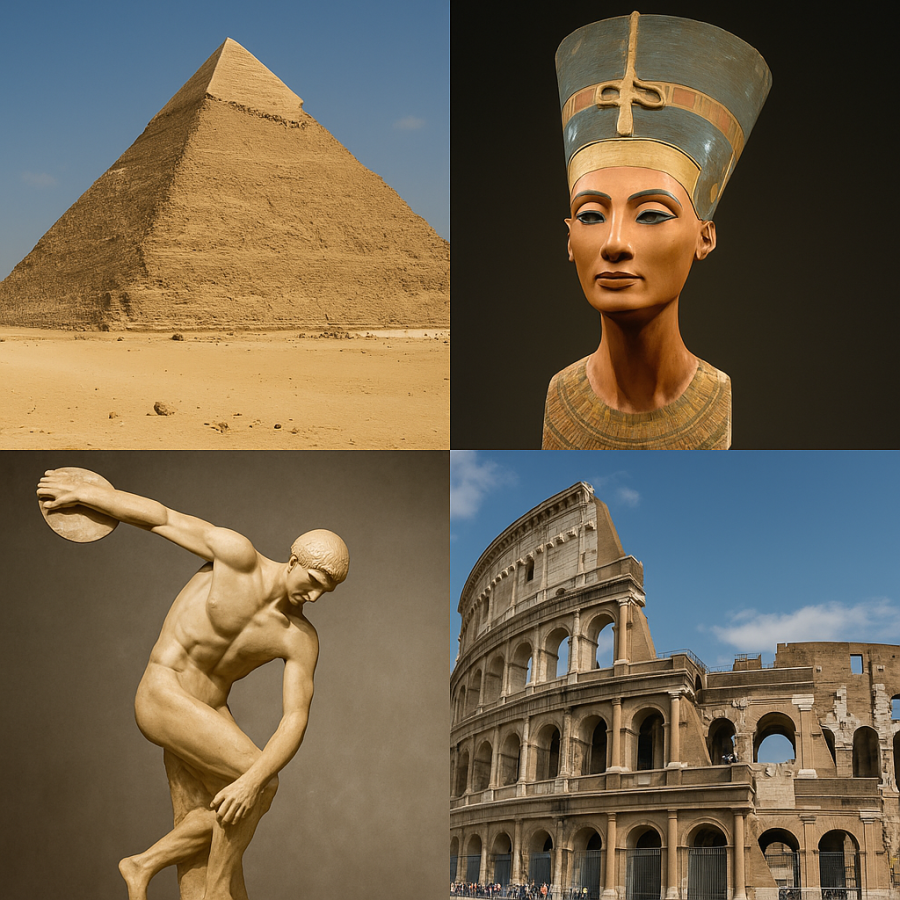Uncovering Art History
The Remarkable Complexity of Ancient Art
19 Apr 2025

Ancient art encompasses various artistic styles and traditions developed by the world's great civilizations, such as Ancient Egypt, Mesopotamia, Greece, Rome, China, and India. Each of these had distinct characteristics and landmark artworks that profoundly influenced the evolution of art.
By ancient art, we mainly refer to the art of ancient Greece and Rome. It is characterized by the ideal of beauty and harmony (perfect proportions, balance), emphasis on the human body (ideal nudes, realistic anatomy), mythological and heroic themes, and monumental architecture (columns, temples, symmetry).
Characteristics and representative artworks of ancient art
Ancient art is a lasting testimony to the civilizations that laid the foundations of universal culture. Over the millennia, ancient peoples created works of remarkable complexity and symbolism, reflecting the religious beliefs, social structures, and aesthetic ideals of their respective eras. Whether we are talking about Egypt, Mesopotamia, Greece, Rome, or Eastern civilizations such as China and India, art has always been closely linked to religious, political, and symbolic functions.
Religious and symbolic functionality
Most works of art in Antiquity had a religious or funerary role, being created to venerate deities, accompany the soul in the afterlife, or glorify rulers. Egyptian pharaohs, for example, built sumptuous tombs for themselves, while in Mesopotamia and Rome art also served as a means of political propaganda. Through these works, power and divinity were visually transmitted to the masses, in an accessible and imposing artistic language.
Durable materials and elaborate techniques
Ancient civilizations placed great emphasis on the durability of works of art, using materials such as stone, bronze, gold, and clay. These not only ensured the longevity of the works, but also reflected the importance that society attached to artistic symbolism. For example, the Egyptian pyramids and Mesopotamian ziggurats were built from massive blocks of stone, intended to withstand time and impress with their monumentality.
Idealization, Stylization, and Conventionalism
Ancient art is characterized by a rigorous stylization of forms and an idealization of beauty. Egyptian and Mesopotamian art adopted a frontal, rigid perspective, with strict rules regarding proportions and body positioning – such as the law of frontality in Egypt. In contrast, the Greeks developed an artistic style that celebrated the ideal beauty of the human body, in movement, in balance, and harmony. This shift from conventionalism to naturalism highlights the evolution of the aesthetic vision in Antiquity.
The influence of mythology
Mythology was an inexhaustible source of inspiration for ancient artists. Gods, heroes, and their legends were transposed into sculptures, paintings, and reliefs, with the aim of educating, impressing, and sacralizing public space. Greek, Roman, and Mesopotamian art abounds in mythological representations, and through them not only stories were transmitted, but also moral values, ideas about power, destiny, and virtue.
Monumental Architecture
A defining element of ancient art is grandiose architecture. Temples, palaces, pyramids, and colossal statues were not just functional structures, but expressions of power and belief. Monumentality was intended to impress and assert the authority of those who commissioned them—whether gods or rulers.
Representative works of ancient art
Each civilization left behind emblematic works that illustrate the specificity and artistic genius of the era.
In Ancient Egypt:
• The Great Pyramid of Giza – a symbol of eternity and ancient engineering genius.
• The sculpture of Nefertiti – a feminine ideal of grace and perfection.
• The tomb of Tutankhamun – a capsule of the Egyptian funerary world, full of religious artifacts and paintings.
In Mesopotamia:
• Ziggurats – stepped temples, symbols of the ascent to divinity.
• The Code of Hammurabi – a basalt stele, valuable as both an artistic and legal object, presenting the king before the god of justice, Shamash.
In Ancient Greece:
• The Parthenon – a masterpiece of Doric architecture, dedicated to the goddess Athena.
• The Discobolus of Myron – a sculpture that captures dynamism and proportion.
• Venus de Milo – an iconic example of ideal feminine beauty.
In Ancient Rome:
• The Colosseum – a huge space intended for public spectacles and the assertion of imperial authority.
• Trajan's Column – a narrative bas-relief that recounts the campaigns in Dacia.
• The equestrian statue of Marcus Aurelius – a rare example of a preserved bronze statue, illustrating imperial power.
In Ancient China:
• The Terracotta Army – an impressive manifestation of the belief in the afterlife and the power of Emperor Qin Shi Huang.
• Buddhist pagodas – sacred buildings, symbols of Buddhist faith and influence.
In Ancient India:
• The Buddha statue at Sarnath – an example of spiritual and contemplative art.
• Kailasa Temple in Ellora – carved directly into the rock, a symbol of devotion and artistic mastery.
Ancient art is more than just an aesthetic expression – it reflects the essence of the societies that created it: their religion, power, mythology, ideals and aspirations. Through its monumental, symbolic and meaningful works, ancient art continues to inspire us and remind us of the greatness of the beginnings of human culture. The legacy of these civilizations is alive not only in museums and archaeological sites, but also in the cultural values of the modern world.
These works demonstrate the diversity and grandeur of ancient art, profoundly influencing later eras. Later, the Renaissance (14th–16th centuries) was a period of return to classical Greco-Roman values, after the Middle Ages. People began to appreciate reason, science, and the beauty of ancient art again.
* * *
Story by Cosmina Marcela Oltean (Gallery curator & Art writer)
All news